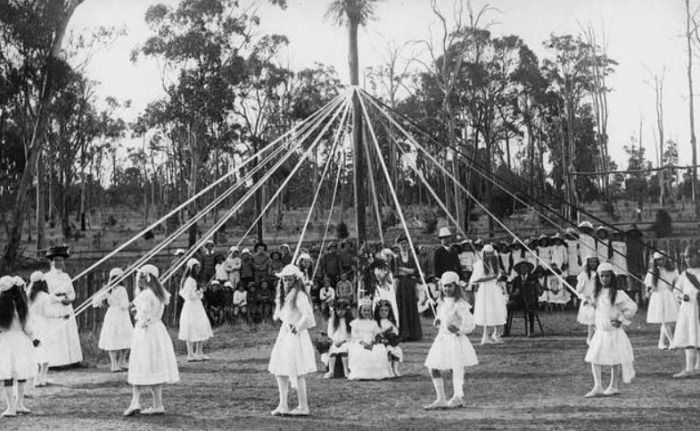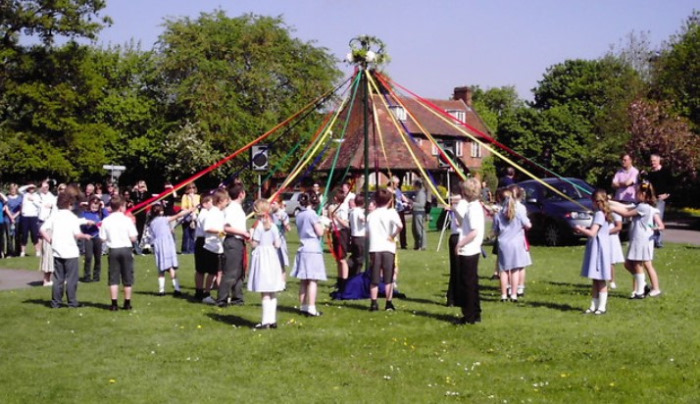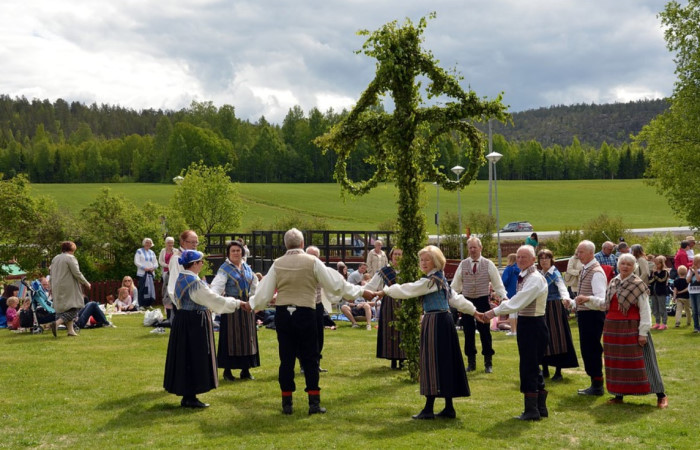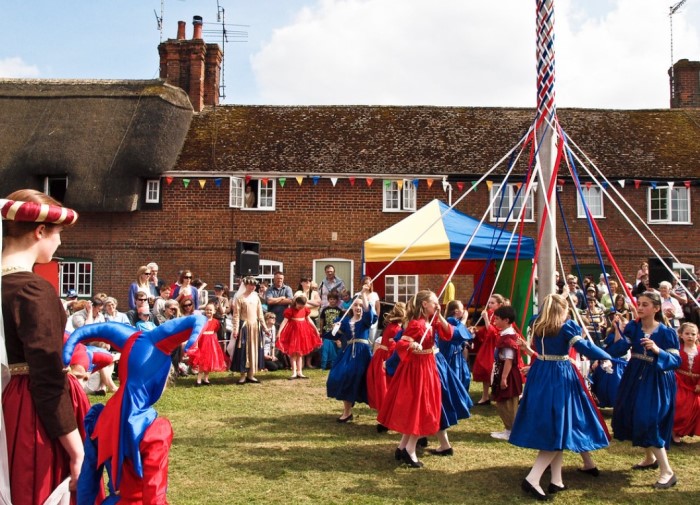If you visit the smaller communities in Europe during May and visit their folk festivals, there’s a good chance that you will see people doing the Maypole dance.
And just like every folk dance slash ritual out there, the Maypole dance actually has a pretty intriguing history behind it.
Plus, who knows, if you travel far enough and come to the right place at the right time, maybe you’ll be invited to join the circle around the maypole, too! In that case, it’s always good to come prepared with basic knowledge about the dance.
In this article, we’ll tell you everything that you need to know about the Maypole dance!
Table of Contents
What Is Maypole Dancing?
The literal centerpiece of the dance is the maypole. It is usually a tall wooden pole decorated with garlands, flowers, and ribbons by the dancers.
Depending on the locality or the country, the pole may be decorated with symbols associated with that place or community.
So, maypoles are going to look different from place to place.
With the pole raised and decorated, dancers will concentrate around the pole and dance in circular patterns around it. But in some countries, there are variations to the dance, too.
For example, in the United Kingdom, the dancers will hold ribbons attached on one end to the pole in their hands. They will dance and weave the ribbons together until they are woven around the pole in a complex yet beautiful pattern.

– Source: https://jenikirbyhistory.getarchive.net/
Maypole Dance History
Maypole dancing has been around for a very long time. There are very few historical records that can pinpoint the exact time and place that it began.
However, most of the sources we have found all said that Maypole dancing first appeared in the British Isles around AD 1350 and 1400.
According to one source, maypoles were erected by people to pray for a year filled with warmth and comfort.
Another said that the tradition of Maypole dancing was started by soldiers in Roman Britain to commemorate the start of the spring season and to thank the goddess of flowers and spring, Flora.
An interesting origin story that we have seen being discussed by some sources is that the Maypole dance is actually a pagan ritual. However, there is very little evidence that supports this theory.
But while we don’t know much about ancient Maypole dancing, we know quite a bit more about modern iterations of this dance.
The “modern” Maypole dancing came about during the 18th century. It was quite popular in Italy and France during this time but was prevalent in other regions, such as Scandinavia.
Also, the tradition of tying ribbons to your hands and dancing around the pole is, surprisingly, a fairly new development. It came about in London.
Teachers quickly caught up and began to teach their children the ribbon dance. The ribbon dance is still done in classrooms and around the country today!
But whatever the tradition is, the Maypole dance is almost always performed around May Day (1st of May.) This is the case for most European nations since it marks Labor Day there.
The only exception is in Sweden, where the maydance is typically performed at midsommar (midsummer.)
The Maypole
The maypole is pretty similar to the Christmas tree. It was originally a living tree.
Every year, in preparation for May Day, people will look for a tree of the right size, age, and type. The poles are typically made from pine or birch, often around 8 feet tall. People will harvest that tree and turn it into a maypole.
According to some sources, the tree symbolizes masculinity with strength and solidness. Meanwhile, the ribbons and decorations wrapped around them represent more feminine energy.
In certain variations, ribbons will also be involved. They can be made from any material, so long that they are strong enough to be woven without breaking.
One end of the ribbons is usually attached to the pole. The dancers will go around the maypole in circles, weaving them together into patterns.
There are two ways for ribbons to attach to the pole. One is to tie the ribbons to a disc and attach that disc to the top of the pole.
If the ribbons are expected to be braided, the ribbons are attached to the top of the pole to ensure that they remain in one place and people can “weave” them.
How To Do A Maypole Dance
The Maypole dance is usually performed as part of a ceremony or ritual, so there should be a dramatic flair to it.
Introductory Dance
This is the simplest step that you can learn.
According to the rhythm of the music, the dancers will take four steps forward, then four steps back in counts of eight.
As they approach the maypole, they can raise their arms into the air, lowering as they back away.
First Plaiting Dance
When the music starts, the dancers will converge in circles around the maypole and pick up their ribbons.
In the plaiting dance, ribbons are attached to a non-spinning (static) plate fixed to the top of the maypole. As the dancers move around in circles, the ribbons will weave around the pole and plait onto it.
This is called the closed plait dance.
A different variation of the dance also exists, where the ribbons will plait away from the pole. This is called open plaiting. A good example of this dance is the Gypsies’ Open Tent dance.
The Grand Chain
In the Grand Chain, the dancers are separated into two groups in equal numbers. Members from each group will partner up with members of the other group.
The dancers are organized so that Group A and B people will be spaced alternatively around the maypole. Members from Group A should face those from Group B as the music starts.
As the rhythm progresses, members from Group A will pass by the right shoulder of their partners from Group B, then leave with the next without turning back on themselves.
The dance will progress until the ribbons are woven up.
As the dancers pass one another, their arms will raise to ensure that the ribbons they hold will weave into their partners’.
Certain performances will also have the unwinding of the ribbons. In that case, the dancers will retrace their steps, passing their last partner, and alternate their shoulders until the ribbons become free.
At the end of the weaving, a complex pattern made from interlaced ribbons will appear on the maypole!
The Gypsies’ Tent
The Gypsies’ Tent is a great example of an open plait dance.
In this dance, instead of weaving patterns onto the pole, you will have to unravel it. A web of ribbons will be strung from the top of the maypole. The objective of the dancers is to unravel it and extend it away from the pole in an open plait.
In the dance, people from Group A will stand next to their partners from Group B.
As the music starts, dancers from Group A will start to move around people from Group B, who will stand still.
They will weave to the right and around the dancer from Group B standing next to their partner, then return to their partner again. They will dance around Group B’s member to the left of their partner, then back again.
If they wish to unwind the ribbon, they can retrace their steps.
Even the Gypsies’ Tent has its variations. The groups can take turns to move, or the members from Group A pass those from Group B, and instead of continuing their movements, they will dance around them instead.
Different variants will have different moves, but the result should still be the same: the ribbons should be unwound at the end of the dance.
Maypole Dance Costumes
Since the Maypole dance is a traditional folk dance, dancers usually wear traditional attire.
There are many legends and stories about the Maypole dance costume. One story goes that in one region, the costume is made from nightgowns decorated with flowers, ribbons, and satin.
In reality, depending on where the dance is, the costumes are going to be different. But it should have a general vibe: long, flowy dresses decorated with flowers and ribbons.
People will try to stand out from the crowd of dancers so they will wear different colors.
Maypole Dancers
The Maypole is open for everyone to dance around. However, the dance is traditionally done by young girls.
Around the world, female dancers will be the primary dancers, while – if they are part of the occasion – males will be in a supportive role.
The Maypole dance is very popular in elementary schools and even pre-schools. You will find many videos of the Maypole dance performed by children as young as three and four.
But most popular, it’s done by kids in elementary school twirling and twining the ribbons.
A Maypole dance will usually consist of 12 to 16 dancers. But if the gathering is large enough, you can expand to as many as 25 dancers.
If you decide to go for higher numbers, ensure that the number of dancers is even. You want everyone to have a partner to twine their ribbons with.
Maypole Dance Music
Any kind of music that is youthful and spring-like is okay. But there’s a tradition to dance to the tunes of “Maypole Dance” from RCA Victor Folk Dancing Orchestra.
Check more: Tarantella Dance: Origin, Steps, Music & More
FAQs
People have sent us many questions about the Maypole dance. Here is our selection of the best questions and their answers!
What Does the Maypole Dance Represent?
Since the Maypole dance is so popular, its meaning will depend from place to place. Most popular, it’s danced to celebrate the arrival of May Day.
In Sweden, the Swedish maypole dance is performed to celebrate the middle of the summer in a festival called midsommar.
Where Did the Maypole Dance Come From?
The Maypole dance originates from the British Isles, according to many sources. It has long since spread through Europe.
How Long Should Maypole Ribbons Be?
The maypole ribbon should ideally be around 20 feet long, between two to three inches wide.
You’ll love: Fan Dance: History, Types, Costume, Notable Dancers & More
Final Words
The Maypole dance is a beautiful folk dance that, to some people, represents the lively spirit of Europe. If you have the opportunity to visit any country in the content around May, check out local folk festivals and buy yourself a ticket!
If you’re lucky enough, you will be able to see a maypole being raised and decorated. Maybe you would be invited into the circle, too!
Have you ever participated in a Maypole dance before? What was your experience like? Tell us in the comment section!



I’d believe this dance has origins in gypsy culture and I am familiar of the term “Gypsies Tent” , being a variant of unraveling the ribbons